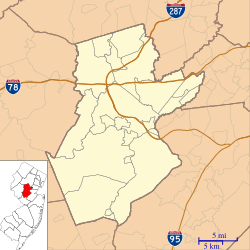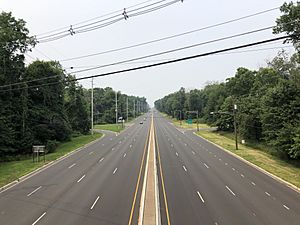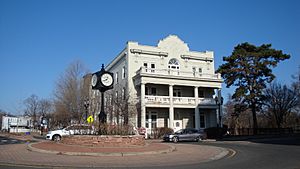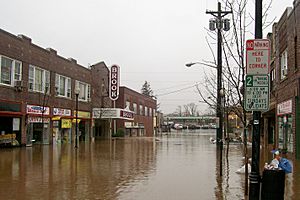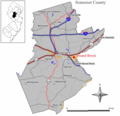Bound Brook, New Jersey facts for kids
Bound Brook is a borough in Somerset County, New Jersey. It's located right along the Raritan River. As of 2020, about 11,988 people live there.
Bound Brook was first set up as a town in 1869. Later, in 1891, it became a borough after people voted for the change.
Quick facts for kids
Bound Brook, New Jersey
|
||
|---|---|---|
|
Borough
|
||
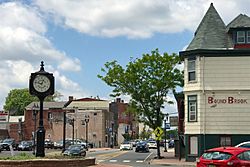
Bound Brook Hotel on Main Street
|
||
|
||
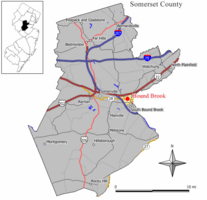
Location of Bound Brook in Somerset County highlighted in yellow (right). Inset map: Location of Somerset County in New Jersey highlighted in black (left).
|
||
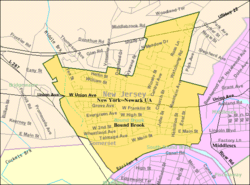
Census Bureau map of Bound Brook, New Jersey
|
||
| Country | ||
| State | ||
| County | ||
| Incorporated | February 11, 1891 | |
| Named for | Bound Brook (Raritan River) | |
| Government | ||
| • Type | Borough | |
| • Body | Borough Council | |
| Area | ||
| • Total | 1.70 sq mi (4.39 km2) | |
| • Land | 1.66 sq mi (4.30 km2) | |
| • Water | 0.03 sq mi (0.09 km2) 2.00% | |
| Area rank | 432nd of 565 in state 18th of 21 in county |
|
| Elevation | 43 ft (13 m) | |
| Population
(2020)
|
||
| • Total | 11,988 | |
| • Estimate
(2023)
|
12,371 | |
| • Rank | 212th of 565 in state 10th of 21 in county |
|
| • Density | 7,217.3/sq mi (2,786.6/km2) | |
| • Density rank | 64th of 565 in state 3rd of 21 in county |
|
| Time zone | UTC−05:00 (Eastern (EST)) | |
| • Summer (DST) | UTC−04:00 (Eastern (EDT)) | |
| ZIP Code |
08805
|
|
| Area code(s) | 732 | |
| FIPS code | 3403506790 | |
| GNIS feature ID | 885166 | |
| Website | ||
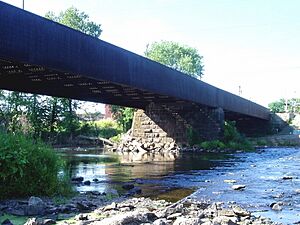
Contents
History
Early Settlement and Name
The area where Bound Brook is located was first settled in 1681. A community grew near a stream called Bound Brook. This stream flows into the Raritan River. The name "Bound Brook" comes from this stream, which was mentioned as a boundary in an old Native American document.
Queen's Bridge
A wooden bridge was built over the Raritan River as early as 1761. It was named Queen's Bridge in 1767. This bridge was very important during the American Revolutionary War. Both sides used it, especially during the Battle of Bound Brook in 1777.
Over the years, the bridge was rebuilt several times. In 1875, a steel bridge replaced the wooden one. Then, in 1984, a new steel bridge was built using the old supports. It was updated again in 2007.
Battle of Bound Brook
The Battle of Bound Brook happened on April 13, 1777. It was part of the American Revolutionary War. In this battle, the American army, called the Continental Army, was defeated by about 4,000 British troops.
Historical Incident
On April 22, 1921, a cloud of gas spread over Bound Brook. This happened because of a broken valve at a paint factory. More than 100 people were hurt, and one person died. Four brave people quickly stopped the gas from spreading further.
Geography
Bound Brook covers about 1.70 square miles (4.39 square kilometers). Most of this area is land.
The borough shares borders with Bridgewater Township and South Bound Brook in Somerset County. It also borders Middlesex Borough in Middlesex County.
Flood Protection
The southern part of Bound Brook, including the downtown area, is a low-lying area near the Raritan River. This means it has sometimes experienced severe flooding after heavy rains. To protect the town, major flood control measures were built between 1999 and 2015. These measures help protect Bound Brook from large floods.
Demographics
| Historical population | |||
|---|---|---|---|
| Census | Pop. | %± | |
| 1870 | 556 | — | |
| 1880 | 934 | 68.0% | |
| 1890 | 1,462 | 56.5% | |
| 1900 | 2,622 | 79.3% | |
| 1910 | 3,970 | 51.4% | |
| 1920 | 5,906 | 48.8% | |
| 1930 | 7,372 | 24.8% | |
| 1940 | 7,616 | 3.3% | |
| 1950 | 8,374 | 10.0% | |
| 1960 | 10,263 | 22.6% | |
| 1970 | 10,450 | 1.8% | |
| 1980 | 9,710 | −7.1% | |
| 1990 | 9,487 | −2.3% | |
| 2000 | 10,155 | 7.0% | |
| 2010 | 10,402 | 2.4% | |
| 2020 | 11,988 | 15.2% | |
| 2023 (est.) | 12,371 | 18.9% | |
| Population sources: 1870–1920 1870 1880–1890 1890–1910 1910–1930 1940–2000 2000 2010 2020 |
|||
In 2010, Bound Brook had 10,402 people. A large part of the population, about 48.66%, identified as Hispanic or Latino. Bound Brook also has one of the highest percentages of people from Costa Rica in the United States.
Parks and Recreation
Bound Brook has created special trails for bikes and walkers along the Raritan River. These trails are a mix of paved and dirt paths, giving residents a great way to enjoy the outdoors.
Education
The Bound Brook School District serves students from pre-kindergarten all the way through twelfth grade. In the 2020–21 school year, the district had five schools and nearly 2,000 students.
The schools in the district are:
- LaMonte-Annex Elementary School (PreK-Kindergarten)
- Lafayette Elementary School (grades 1-2)
- Smalley Elementary School (grades 3-6)
- Community Middle School (grades 7-8)
- Bound Brook High School (grades 9-12)
Students from South Bound Brook, New Jersey also attend Bound Brook High School. The high school joined a program that allows students from other towns to attend its schools. In 2011, the high school started a special biomedical program, adding to its existing engineering program.
There was once a Catholic school in Bound Brook called Holy Family Academy, which served students up to eighth grade. It closed at the end of the 2010–2011 school year.
In 2018, Stephen Kovacs started Kaprica United Fencing Academy in Bound Brook, where he was the head coach.
Transportation
Roads and Highways
Bound Brook has many roads, including Route 28 which goes through the center of town. U.S. Route 22 also passes through the northern part of the borough. Other county roads, like 525, 527, and 533, are also in Bound Brook. Interstate 287 is easily reached nearby in Bridgewater Township.
Public Transit
Bound Brook has its own train station, the Bound Brook train station. You can take NJ Transit trains from here to Newark Penn Station. The historic station building, built in 1913, is now a restaurant. There's a tunnel that connects both sides of the train tracks. Freight trains also use tracks that go past the station.
NJ Transit also offers bus services. You can take buses to Port Authority Bus Terminal in Midtown Manhattan or local buses to Newark. Somerset County also has bus routes that connect Bound Brook to other nearby towns and places like shopping centers and colleges.
Bound Brook Cycling Classic
Every year, Bound Brook hosts a bicycle race called the Bound Brook Cycling Classic. This race is part of a bigger three-day event called the Tour of Somerville, which happens on Memorial Day Weekend. The Tour of Somerville is the oldest professional bike race in the United States.
Natural Disasters
The downtown area of Bound Brook is low-lying and has experienced flooding from the Raritan River. In September 1999, a big flood from Hurricane Floyd damaged many buildings. This led to a large project, the Green Brook Flood Control Project, which built flood protection for the town. This project was completed between 1999 and 2015.
The highest flood levels in Bound Brook happened during Hurricane Floyd in 1999. Other major floods occurred in 1971, 2007, and 2011.
Flooding has also caused fires in Bound Brook's history. For example, during Hurricane Floyd in 1999, a fire started in a motorcycle shop. Because of the floodwaters, firefighters had a hard time reaching the building, and the fire spread to other structures. The Bound Brook Fire Department, with help from other fire companies, worked hard to stop it.
In 2007, the fire department also stopped another fire from spreading through homes during a storm. More recently, on January 12, 2020, a large fire, started by an arsonist, caused a lot of damage to downtown buildings.
Notable People
People who have lived in or are connected to Bound Brook include:
- Isaac Blackford (1786–1859), a judge for the Indiana Supreme Court.
- Margaret Bourke-White (1904–1971), a famous photographer.
- Jeffrey Chiesa (born 1965), who was New Jersey's Attorney General and a U.S. Senator.
- Sylvester Graham (1794–1851), a minister who invented the Graham cracker.
- William H. Johnson (1857–1926), known as Zip the Pinhead, a circus performer.
- Dick Lynch (1936–2008), an NFL football player for the Washington Redskins and New York Giants.
- Ronald Naldi, a singer at the Metropolitan Opera.
- Upton Sinclair (1878–1968), a well-known writer.
- Perry Wilson (1916–2009), an actress.
Images for kids
See also
 In Spanish: Bound Brook para niños
In Spanish: Bound Brook para niños



